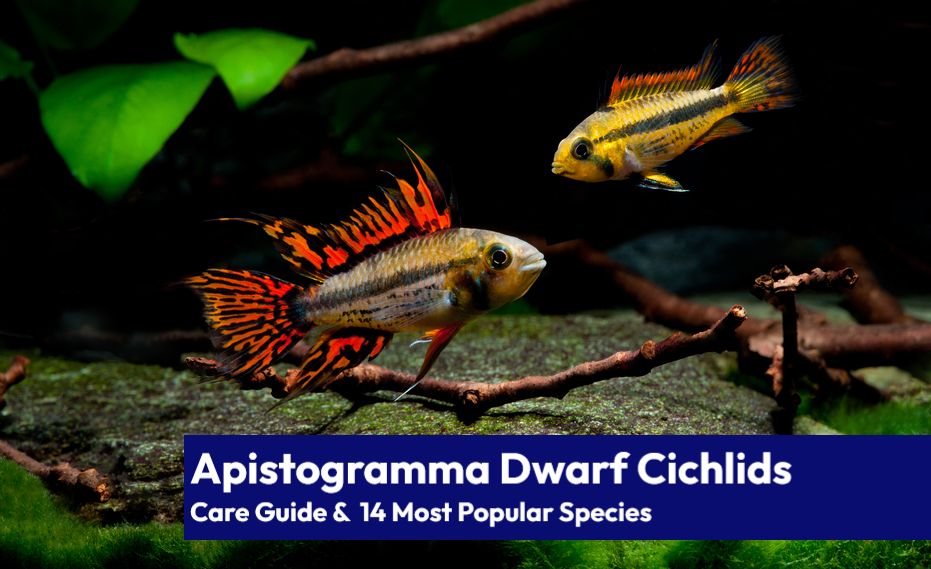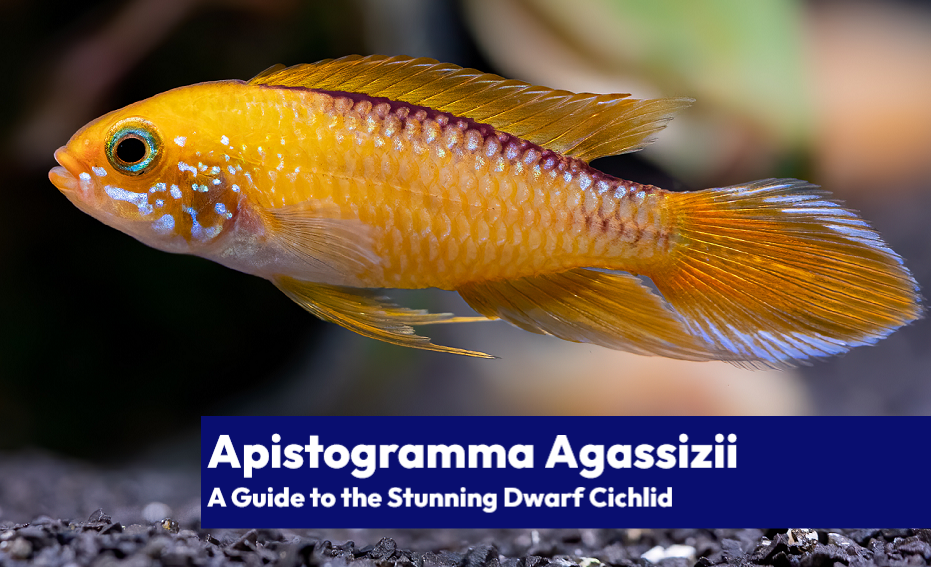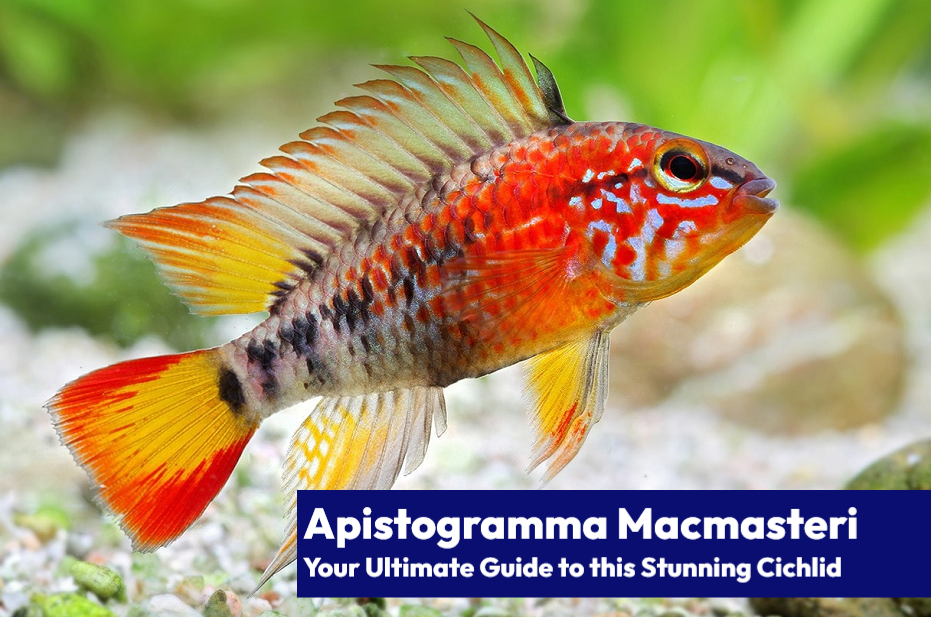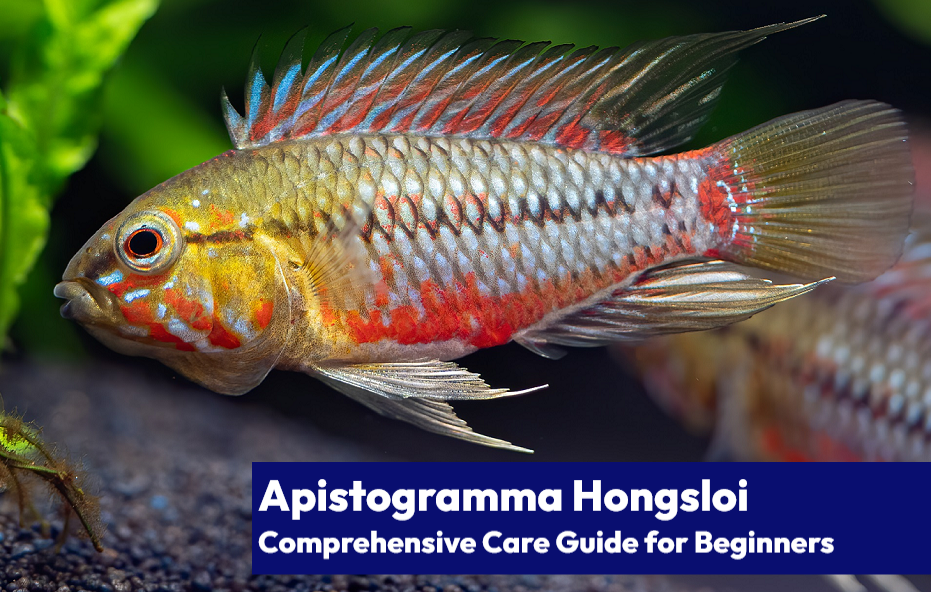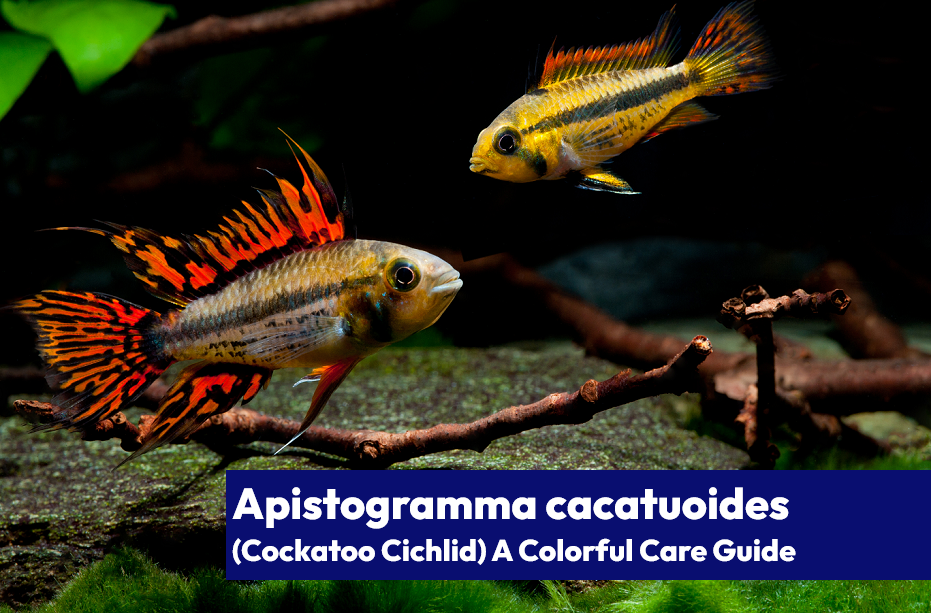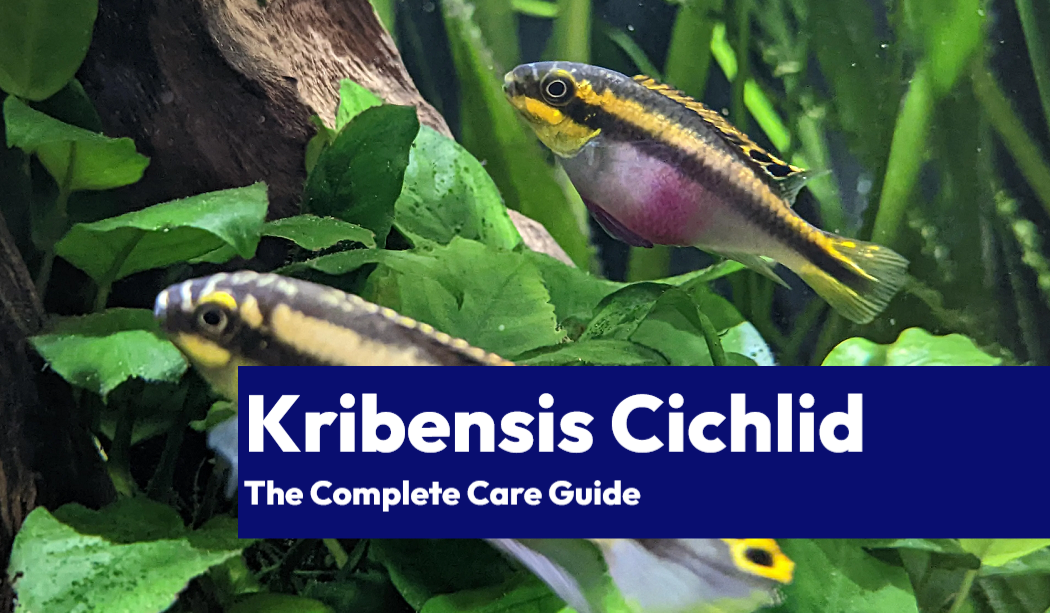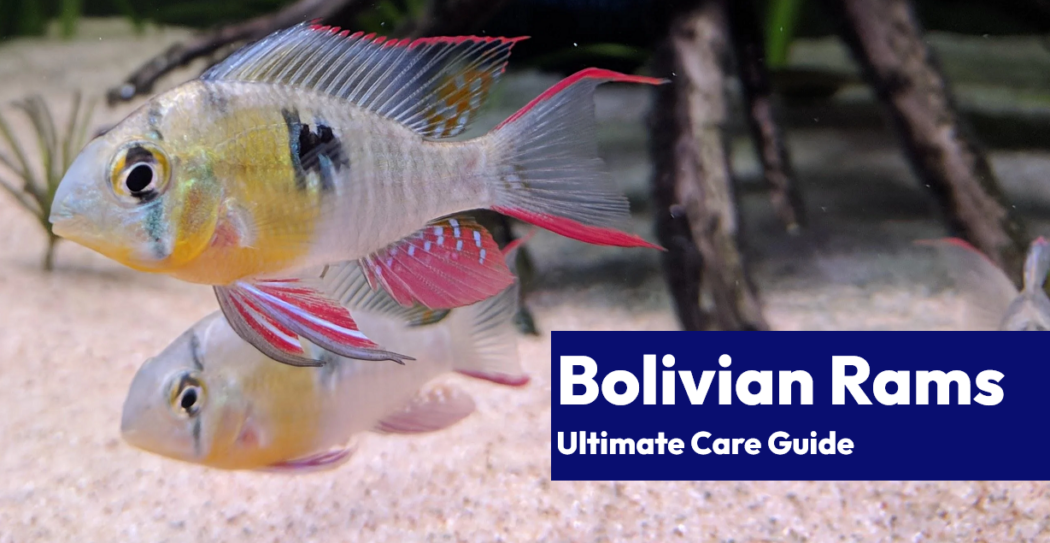Hello my finned-friends fanatics, it’s your aquatic aficionado, Tim Priest, back with another exciting episode of our underwater adventures. Today, let’s dive deep into the world of Apistogramma Cichlids, the kaleidoscope of the aquarium, and a fish that’s as fascinating as my Aunt Bertha’s obsession with knitting. No offense, Aunt Bertha, I love your scarves!
Getting to Know the Apistogramma Cichlids: A Colorful Intro
To the uninitiated, Apistogramma Cichlids might sound like a Latin dance move, but to us fish enthusiasts, it’s music to our ears – a melody of incredible colors, intriguing behavior, and more personality than a stand-up comedian at an open mic night.
Let’s go over the quick facts, kinda like a dating profile for the Apistogramma Cichlids.
| Care Data | Apistogramma Cichlids |
|---|---|
| Scientific Name | Apistogramma agassizii |
| Type | Freshwater |
| Adult Size | 3 inches (7.6 cm) |
| Tank Size | 20 gallons (75 liters) |
| Optimal Temperature | 73-86°F (23-30°C) |
| General Hardness dGH | 5-19 |
| Carbonate Hardness dKH | 2-15 |
| Optimal pH range | 6.0-7.5 |
| Diet Type | Omnivore |
| Feeding Frequency | Twice daily |
| Water Change Frequency | Weekly |
| Can Breed In Captivity? | Yes |
| Number of Fry | 40-80 |
| Spawning Type | Cave Spawner |
| Native Range | Amazon Basin, South America |
| Temperament | Peaceful |
| Schooling/Shoaling Fish | No |
| Known to Jump Out of Tank | No |
| Average Cost (USD) | $10-$30 |
The Painting That Swims: Apistogramma Cichlids Appearance
You know, when Mother Nature was designing the Apistogramma Cichlids, she must’ve been in one of her Picasso moods. These little guys are a canvas of color, with hues that would make a rainbow blush. Their bodies are a tapestry of blues, yellows, reds, and oranges that seem to shimmer and change as they dart around the aquarium.
Talking about their shape, these fellas are laterally compressed, meaning they’ve got a slender, elongated body – like a supermodel of the fish world. Their fins are like the flowing gowns on the runway, especially the males with their elongated dorsal and anal fins.
Now, let’s talk about boys and girls. Apistogramma Cichlids are sexually dimorphic, meaning males and females have distinct appearances. Males are larger, with more vibrant colors, extended fins, and a pronounced hump on their forehead when they reach breeding age. The ladies, on the other hand, are smaller, with less flashy coloration. Kind of like how in the bird world, the boys are all about the bling while the girls keep it classy and understated.
Fabulous Fourteen: The Most Popular Apistogramma Species
1. The Cockatoo Cichlid (Apistogramma cacatuoides)
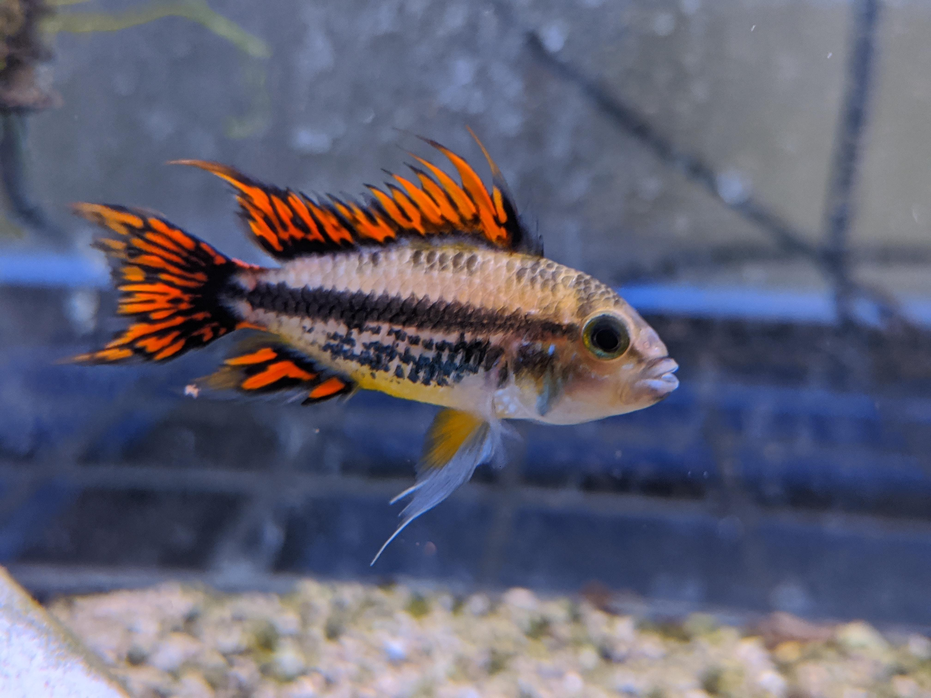
Let’s kick things off with the flamboyant Cockatoo Cichlid, so named for its vibrant hues and cocky disposition. These chaps are like the Elvis Presley of the aquarium—eye-catching, flashy, and guaranteed to leave you All Shook Up. But remember, like Elvis, they prefer their peanut butter and banana sandwiches… err, water conditions, a certain way—soft, slightly acidic, and clean as a hound dog’s tooth.
2. Agassiz’s Dwarf Cichlid (Apistogramma agassizii)
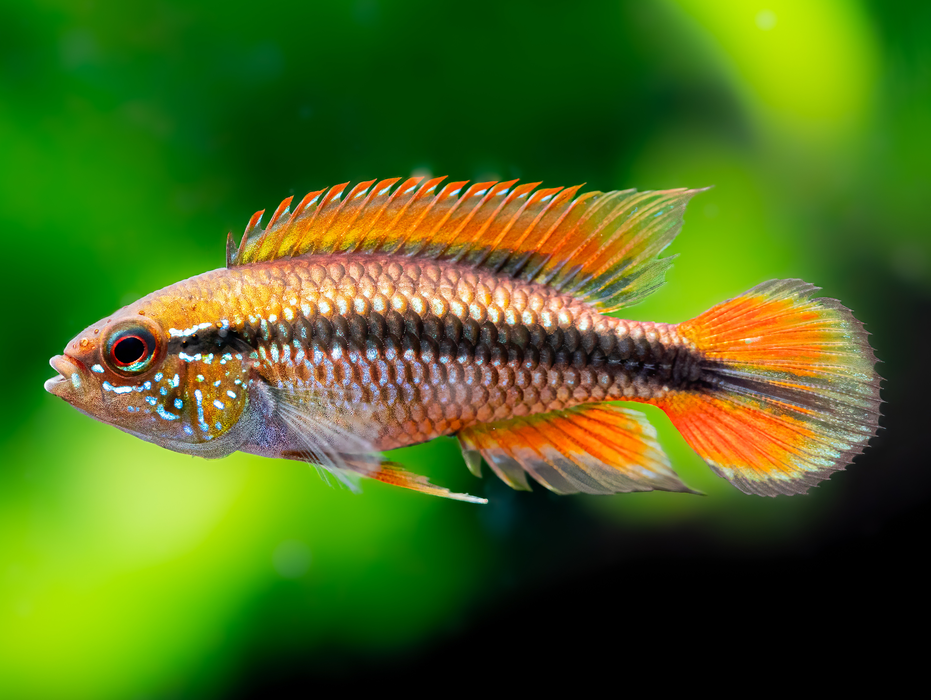
Next, we have Agassiz’s Dwarf Cichlid. Just like your favorite grandma’s antique collection, these little guys are classic and timeless. They’re like the Fabergé eggs of the aquarium world—exquisite and delicate. Remember, though, these Fabergé fishes appreciate a bit of privacy, so be sure to provide plenty of hiding spots in your aquarium.💡Fun Fact: They’re named after famed zoologist Louis Agassiz. Talk about being a name-dropper!
3. Umbrella Dwarf Cichlid (Apistogramma borellii)
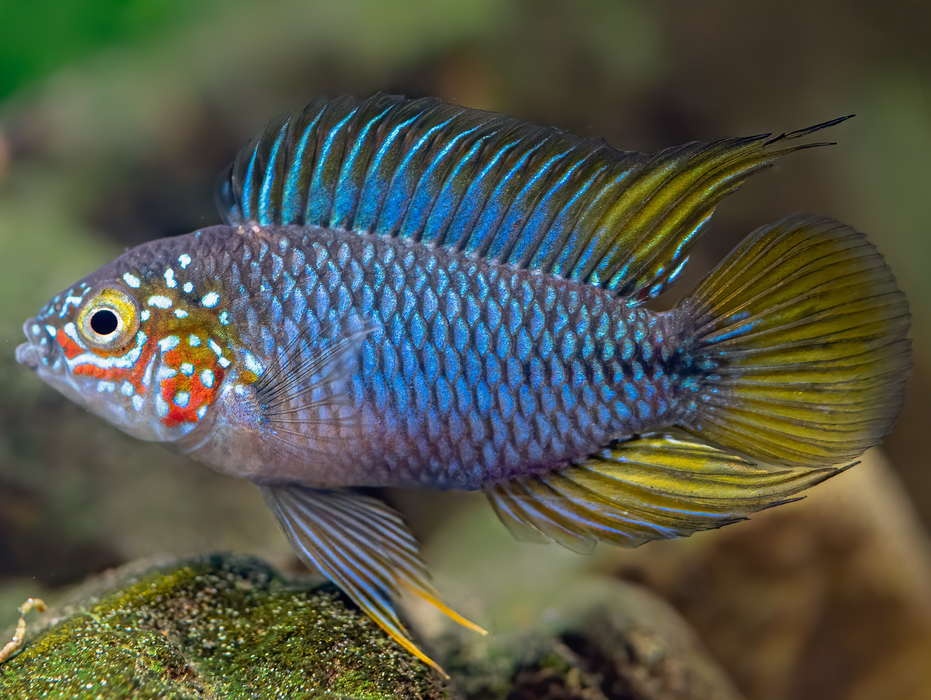
On to the Umbrella Dwarf Cichlid, the wallflowers of the Apistogramma world. They’re like that shy person at the party who turns out to have the most interesting stories. They’re peaceful, unassuming, and have an elegant charm that will grow on you. Like any introvert, they’ll appreciate some quiet time, so ensure a peaceful environment in your tank.
4. Panda Dwarf Cichlid (Apistogramma nijsseni)
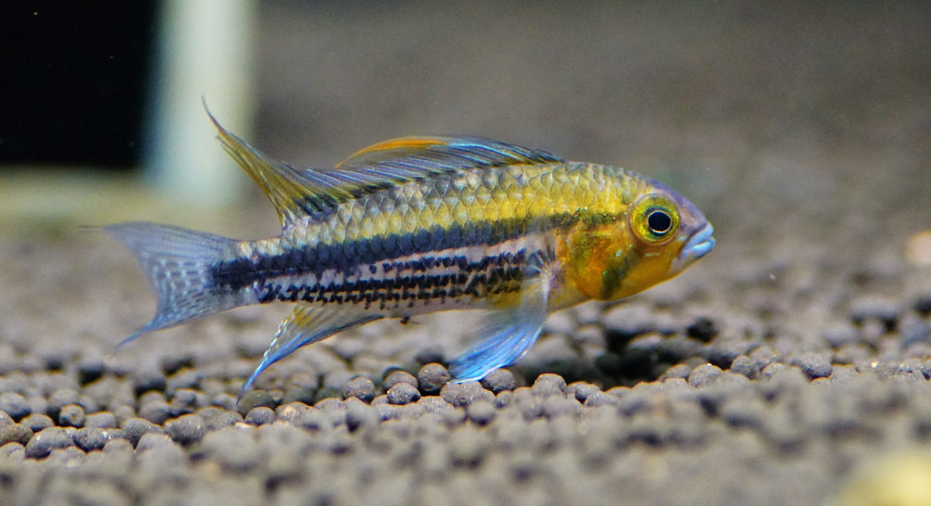
Behold the Panda Dwarf Cichlid! Now, I don’t know about you, but when I think of pandas, I think of adorable, bamboo-munching, and slightly clumsy creatures. Panda Dwarf Cichlids, however, are anything but clumsy. These aquatic acrobats are perfectly suited to navigate the intricate nooks and crannies of your tank. Just remember, these pandas prefer worms to bamboo!
5. Apistogramma bitaeniata
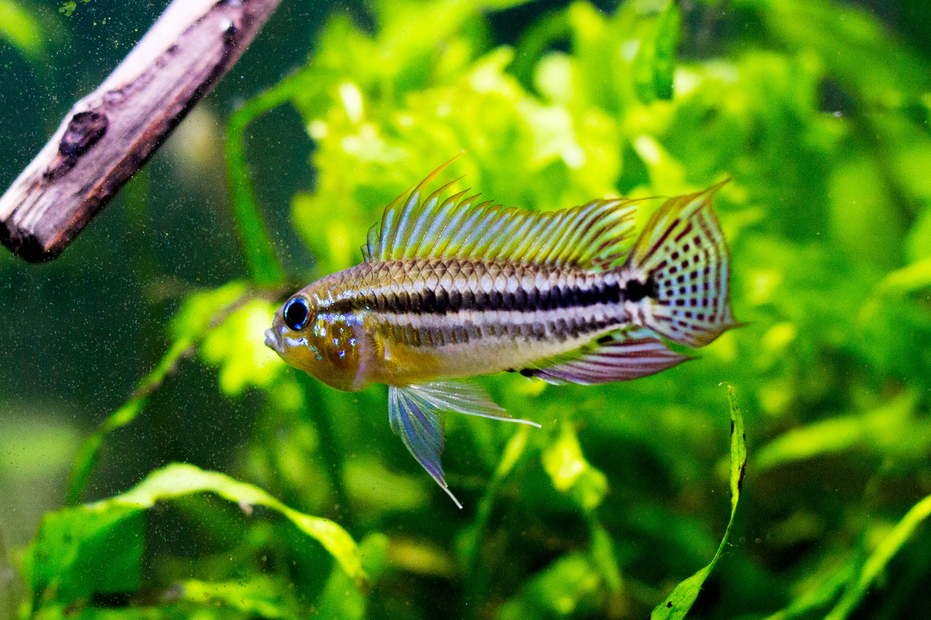
Next up, we have the Umbrella Cichlid. But don’t let the name fool you. These guys aren’t here to shield you from the rain. They’re more like the umbrella you forgot at the café—unassuming at first, but you’ll realize how special they were when they’re gone. So, don’t be that guy. Cherish your Umbrella Cichlids from the get-go.
6. Macmaster’s Dwarf Cichlid (Apistogramma macmasteri)
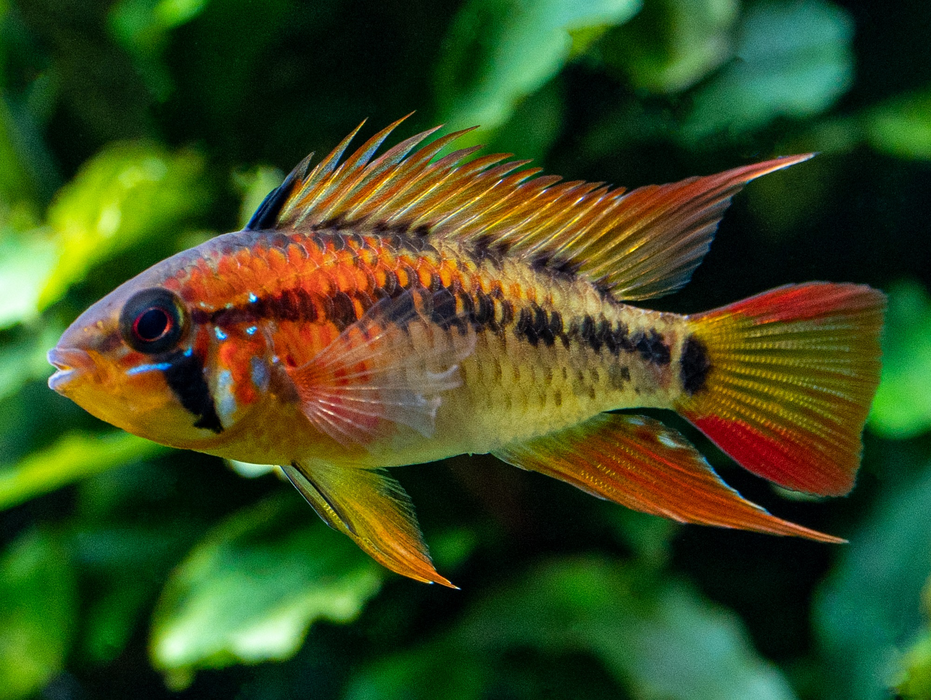
Ah, the Macmaster’s Dwarf Cichlid. If Apistogrammas were a school, these guys would be the headmasters. They’re authoritative, command respect, and are strikingly beautiful. Just like a headmaster, they prefer things orderly and well-structured, so keep your tank clean, folks!
7. Viejita (Apistogramma viejita)
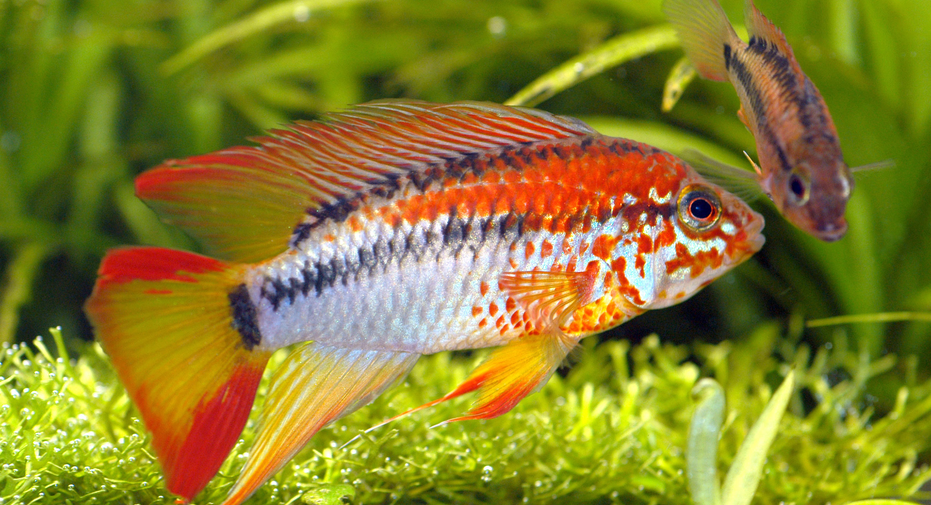
The Viejita is the old soul of the Apistogramma family. Picture your favorite grumpy yet endearing grandpa, except in fish form and with more color. They may seem a little standoffish at first, but with time, you’ll see the gentle and captivating charm that lies beneath.
And remember, old souls love reminiscing about the past, so a tank that mimics their natural environment will make them feel right at home.
8. Hongsloi Dwarf Cichlid (Apistogramma hongsloi)
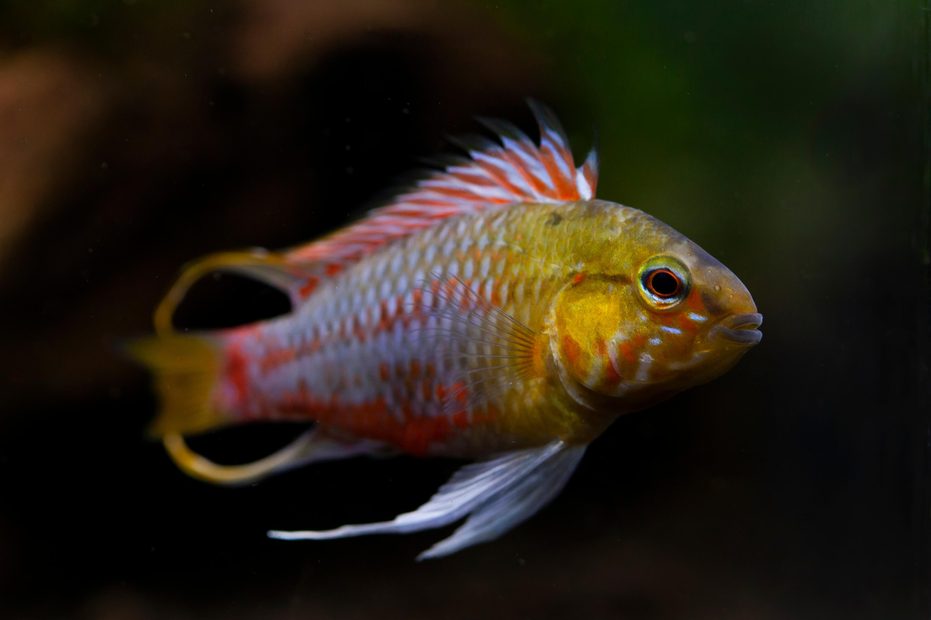
Meet the Hongsloi Dwarf Cichlid, the secret agents of the Apistogramma world. They’re elusive, mysterious, and have an undeniably magnetic allure.
Just like any secret agent, they appreciate a complex environment with plenty of hideouts. And while they might not be saving the world, they’ll definitely save your tank from becoming mundane.
9. Blue Dwarf Cichlid (Apistogramma trifasciata)
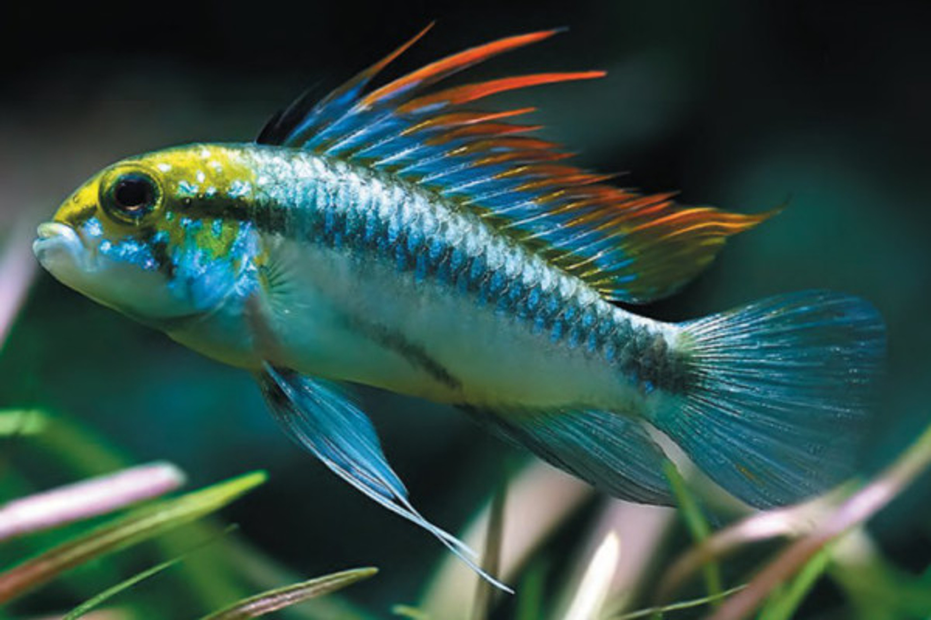
Feast your eyes on the Blue Dwarf Cichlid, the dazzling divas of the Apistogramma universe. They’re the Beyoncé of the fish world – stunning, radiant, and they run the tank. Just remember, divas need the spotlight, so make sure your tank lighting is on point.
💡 Expert Tip: They appreciate a well-planned diet to keep their color poppin’!
10. Tefe Dwarf Cichlid (Apistogramma tefe)
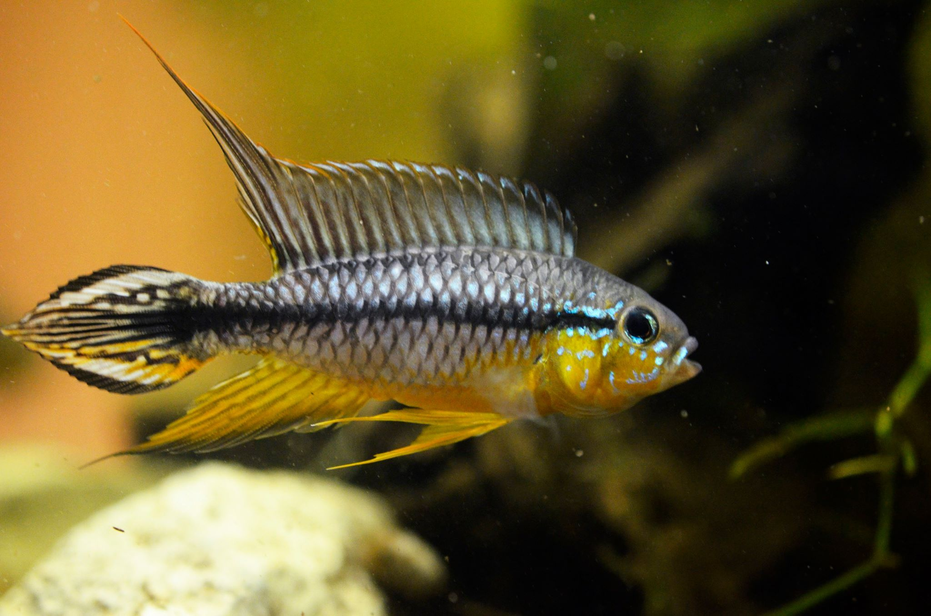
The Tefe Dwarf Cichlid is like the lovable teddy bear you had as a kid—comforting, familiar, and they make you smile every time you see them. They’re the embodiment of joy and tranquility in your tank. Just as your teddy bear needed love and care, these little guys need a well-maintained tank to thrive.
11. Red Tail Dwarf Cichlid (Apistogramma eunotus)
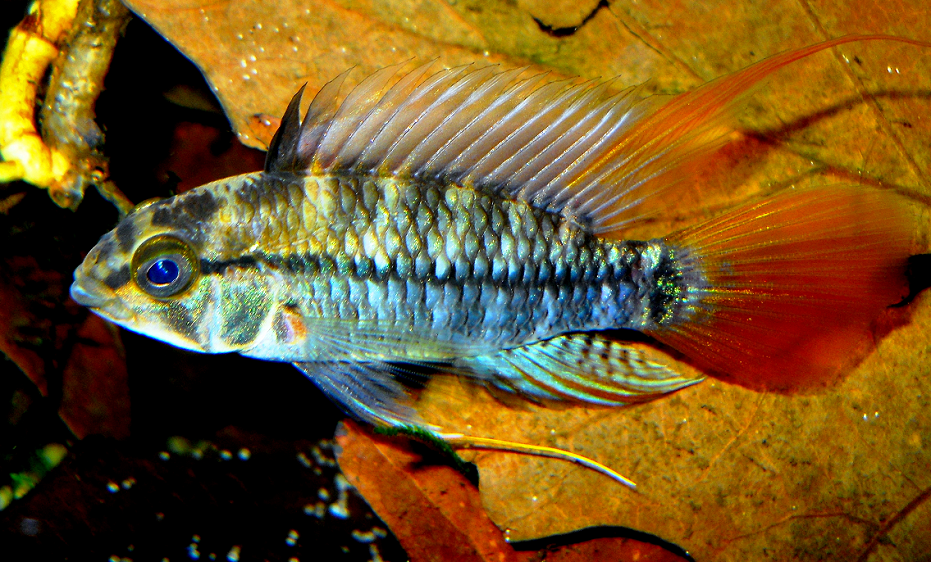
The Red Tail Dwarf Cichlid is the showstopper of the Apistogramma world. They’re the fireworks at the end of the concert—bright, exciting, and they leave a lasting impression. These guys are the cherry on top of your aquatic sundae. Just remember, every firework needs the right conditions to shine, so keep your tank parameters stable.
12. Apistogramma gephyra
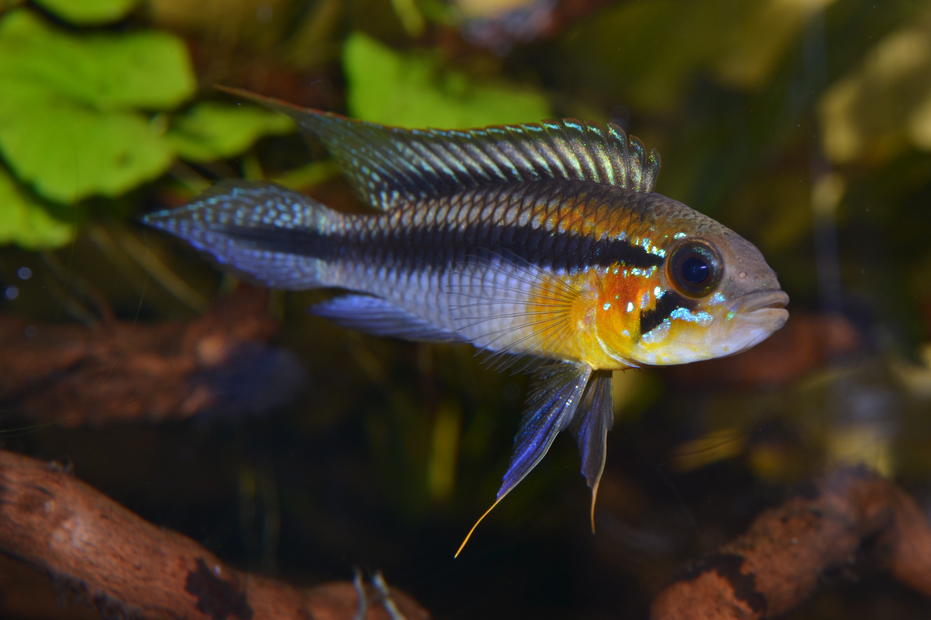
This species is a stunning combination of subtle greys and blacks, like a sultry, smoky-eyed model. They’re like the chic fashionistas of the Apistogramma world, bringing a touch of understated elegance to your tank. Just remember, even though they’re not all about the glitz and glam, they still require an environment with plenty of hideouts and a well-maintained diet to flaunt their best look.
13. Gold Dwarf Cichlid (Apistogramma allpahuayo)
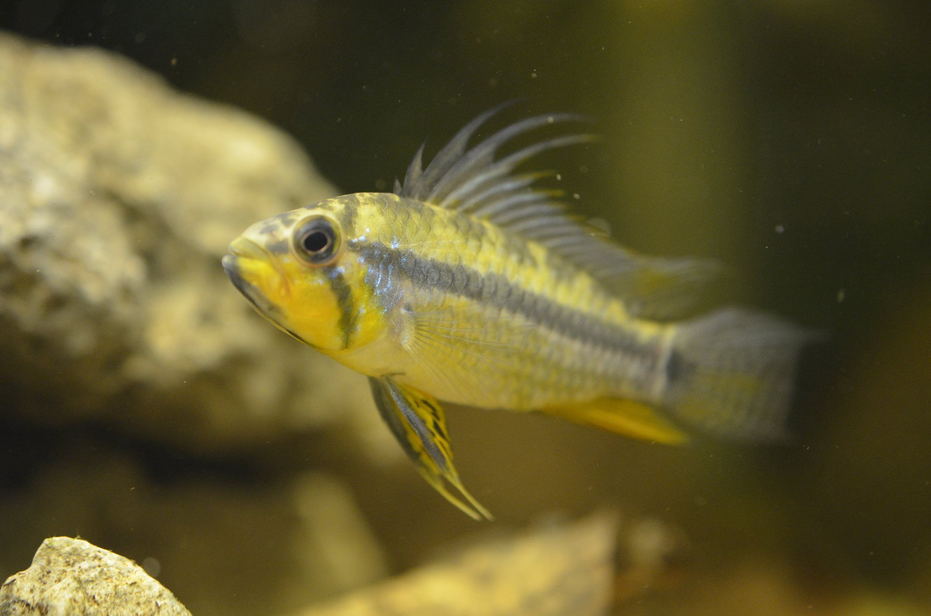
Next up is the Gold Dwarf Cichlid, the Midas of the Apistogramma world. They’re shiny, captivating, and bring a touch of luxury to your tank. Just like King Midas, they appreciate the finer things in life—rich, varied diet and pristine water conditions.
14. Amazon Dwarf Cichlid (Apistogramma elizabethae)
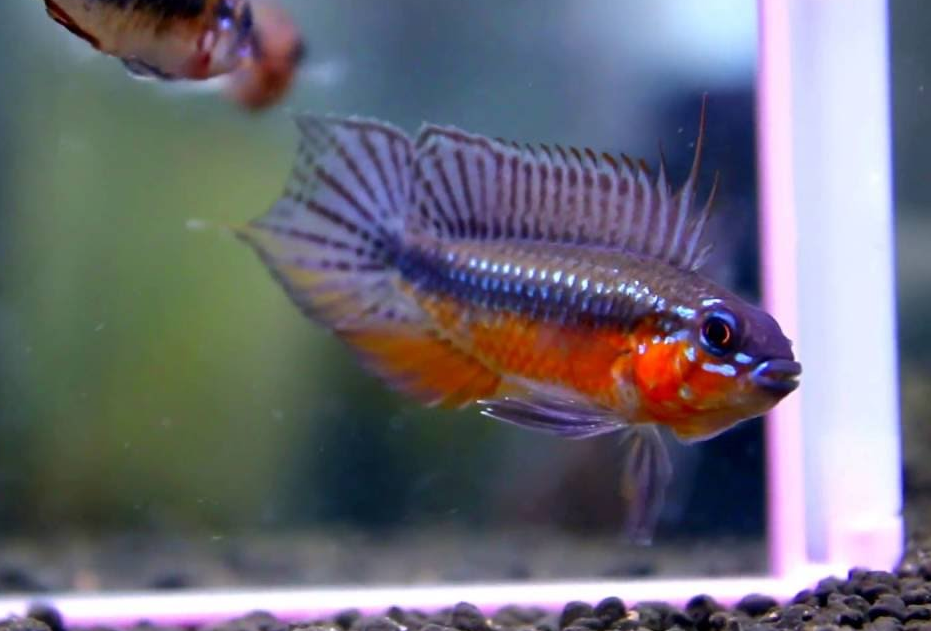
Last but not least, we have the Amazon Dwarf Cichlid. They’re like the jungle explorers of the Apistogramma world—adventurous, rugged, and full of life. These guys bring a bit of the Amazon’s wild charm to your aquarium. Just remember, even explorers need a comfy camp, so a tank that mimics their natural habitat is ideal.
The Underwater Anatomy Lesson: What Makes Apistogramma Tick?
Let’s get to know the Apistogramma Cichlids from the inside out. No, I’m not suggesting fish surgery – we’re just taking a closer look at their unique anatomy.
Like other cichlids, Apistogramma have a single nostril on each side of their forehead. Why? Well, scientists are still puzzled, but one thing is certain: they have a keen sense of smell that helps them locate food and mates. They also have a lateral line system – a series of sensory organs that run along their body, allowing them to detect changes in water pressure. Kind of like Spiderman’s spidey-sense, but for water!
Speaking of superheroes, Apistogramma also have a superpower in their mouths! They possess what’s known as a ‘protractile’ mouth. It’s a fancy way of saying they can extend and retract their jaws like a drawbridge, helping them vacuum up their food in the blink of an eye.
You know what else is cool? Their gill covers. They’ve got these bony plates called opercula protecting their gills. But it’s not just armor – they can also flare them out to appear bigger and scarier when they feel threatened. Kinda like me puffing out my chest when I see a spider… doesn’t work as well for me though.
How Big? How Fast? Average Size and Growth Rate of Apistogramma Cichlids
Apistogramma Cichlids typically reach an adult size of 3 inches (7.6 cm). They’re not the biggest fish in the pond, but what they lack in size, they make up for in personality. Like that short friend we all have who’s the life of the party!
Over their first year, you can expect your Apistogramma to grow rapidly, with males generally growing faster and larger than females. After that, growth slows, but they’ll continue to fill out, becoming more robust and brightly colored. It’s like they hit fish puberty and suddenly become the belle (or beau) of the ball.
Keeping them in a spacious tank with optimal water conditions, a balanced diet, and plenty of mental stimulation will ensure your Apistogramma Cichlids grow to their maximum size. Remember, healthy fish are happy fish!
Lifespan: How Long Do Apistogramma Cichlids Live?
The typical lifespan of Apistogramma Cichlids is between 3 and 5 years, with some even reaching up to 7 years in ideal conditions. Now, that might not seem like a long time, but remember, they’re living their best fish life every second of it!
Of course, their lifespan is heavily influenced by factors like diet, water quality, stress levels, and even their genetic make-up. It’s like how humans can live longer with a balanced diet, regular exercise, and avoiding stress. Except, for Apistogramma, that translates to balanced meals of worms and crustaceans, plenty of swimming space, and no rowdy tankmates.
Home, Sweet Home: The Ideal Tank Size for Apistogramma Cichlids
Considering Apistogramma Cichlids grow up to 3 inches (7.6 cm) and they’re not schooling fish, a minimum tank size of 20 gallons (75 liters) should suffice. But hey, who doesn’t love a bit of extra room to swim?
If you plan to keep a group or add tank mates, I recommend going with a 40-gallon (151 liters) tank. It’s like upgrading from a studio apartment to a spacious condo – more room for activities!
Remember, an aquarium is not just a tank of water; it’s a world for your fish. A larger tank provides more territory, reduces aggression, and allows for a more stable environment. It’s like having your own kingdom where you’re the benevolent ruler, and your subjects are fish.
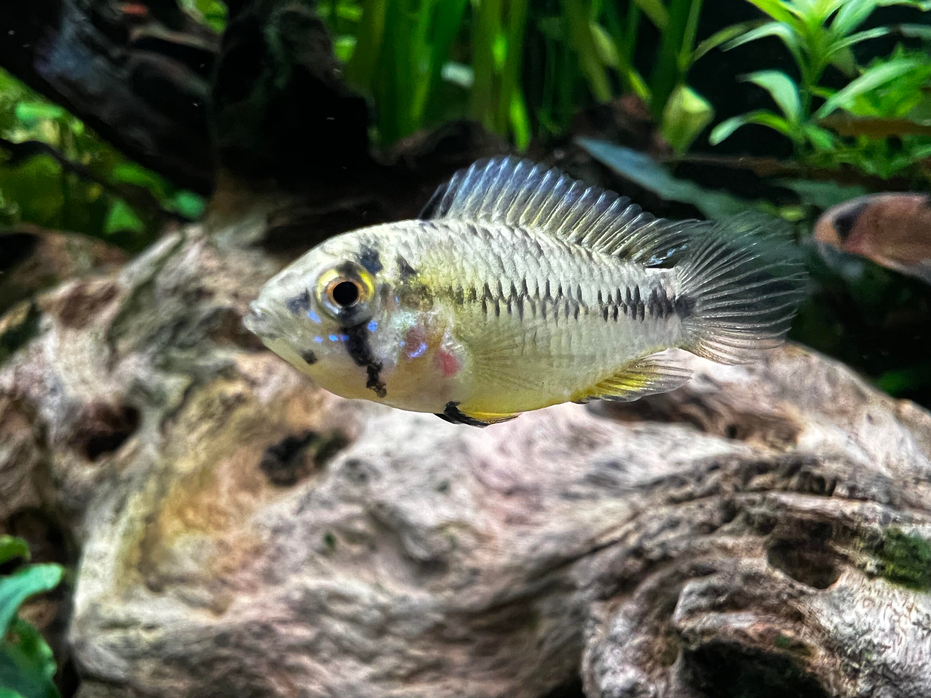
The Perfect Brew: Water Parameters for Apistogramma Cichlids
Apistogramma Cichlids thrive in water temperatures of 73-86°F (23-30°C), with a pH range of 5.0-7.0. They prefer softer water, with a general hardness (dGH) of 1-10 and a carbonate hardness (dKH) of 1-5. It’s like they’re the Goldilocks of the fish world, everything has to be just right!
A Fish’s Shopping List: Required Equipment for Apistogramma Cichlids
A fish tank isn’t a fish home without the right equipment. It’s like moving into a new house without any furniture or appliances – it’s empty and not very comfortable. So, let’s get your fish some furniture!
First off, we need a heater. For a 20-gallon tank, I recommend a 100-watt heater to keep the temperature steady in the 73-86°F (23-30°C) range. Remember, Apistogramma Cichlids are like tropical vacationers – they love the heat!
Next, let’s talk filters. A sponge filter is a solid choice for Apistogramma Cichlids. It provides biological filtration without creating strong currents – perfect for these little guys who aren’t the strongest swimmers.
For lighting, an LED light with a timer is ideal. It helps simulate a day/night cycle and can even encourage plant growth. It’s like creating a 24-hour mood lighting for your fish.
Making a House a Home: Habitat Requirements for Apistogramma Cichlids
Apistogramma Cichlids hail from the sandy bottoms of the Amazon, so a sandy substrate would make them feel right at home. Plus, they love to dig, so the softer the better. It’s like giving a kid a sandbox – hours of fun!
For decor, think about adding some driftwood or rocks. They provide hiding spots and can also help mimic their natural environment. Apistogramma Cichlids are like introverts at a party, they like to have a corner to retreat to when things get too rowdy.
If you’re thinking of adding plants, here are some that play nice with Apistogramma Cichlids:
Remember, plants aren’t just for aesthetics, they also provide cover, reduce stress, and improve water quality. It’s like having houseplants that also clean your air!
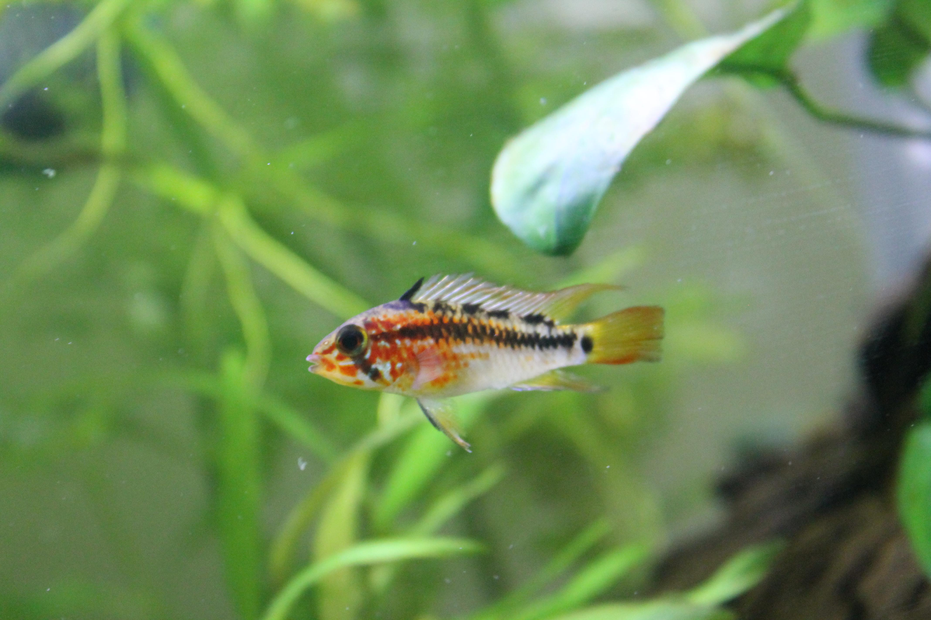
Chow Time: Diet of Apistogramma Cichlids
Apistogramma Cichlids are omnivores, which means they’ll eat pretty much anything. But that doesn’t mean you can just toss in anything and call it a day. Here’s a list of optimal food items for our little friends:
- Brine Shrimp
- Bloodworms
- Daphnia
- Mysis Shrimp
- Tubifex Worms
- High-quality flake or pellet food
- Vegetable matter
- Fruit flies
- Mosquito larvae
- White worms
Feeding should be done once or twice a day, with only as much food as they can consume in 3 minutes. Overfeeding can lead to water pollution and health problems. It’s like having an all-you-can-eat buffet at every meal – sounds fun, but it’s not the best idea.
💡 Pro Tip: Mix up your Apistogramma’s diet to ensure they get all the nutrients they need. Variety is the spice of life after all
The Social Life of Apistogramma Cichlids: Behavior and Temperament
Let’s talk about fishy social dynamics! Apistogramma Cichlids are generally peaceful, but they can be territorial, especially during breeding season. They’re like that guy at the gym who’s generally nice but gets a little aggressive when someone tries to take his favorite treadmill.
Apistogramma aren’t schooling fish, but they do well in groups, especially with one male to several females. And if you’re lucky, you might catch a glimpse of their unique courting behavior. Males will display their fins, change colors, and perform a dance to woo females. It’s like watching a fishy version of “Dancing with the Stars”!
While they aren’t the most active swimmers, Apistogramma Cichlids love to explore their surroundings. They’ll often be seen darting in and out of caves, burrowing in the substrate, or hanging out in the plants. It’s like they’re playing a perpetual game of hide and seek!
💡 Fun Fact: Apistogrammas can change their color depending on their mood, health, or to assert dominance. It’s like having a mood ring, but for a fish!
The Good, The Bad, and The Ugly: Ideal and Not-so-ideal Tankmates for Apistogramma Cichlids
When it comes to cohabitation, not all fish are created equal. Here are some species that would make great roomies for your Apistogramma Cichlids:
- Cardinal Tetras
- Corydoras Catfish
- Otocinclus Catfish
- Dwarf Gourami
- Harlequin Rasboras
- Hatchetfish
- Glass Catfish
- Rummy Nose Tetras
- Zebra Danios
- Glowlight Tetras
On the flip side, some fish just aren’t cut out to be Apistogramma roommates. Here are a few to avoid:
- Large, aggressive Cichlids
- Goldfish
- Tiger Barbs
- Bettas
- Common Plecos
When picking tankmates, remember that Apistogramma Cichlids are relatively small and peaceful. They can easily be bullied by larger, more aggressive fish. It’s like putting a quiet bookworm in a room with a heavy metal band – not the best match!
The Birds and the Bees of the Fish World: Breeding Apistogramma Cichlids
Breeding Apistogramma Cichlids is like a real-life soap opera, full of dramatic displays, territorial squabbles, and doting parents. Here’s the scoop:
First off, you’ll want to have a male and a few females in your tank. The male will court the females with flashy displays and smooth dance moves. If a female is interested, she’ll follow the male to a suitable spawning site, usually a cave or a crevice.
Once the eggs are laid and fertilized, the female takes over parental duties. She’ll guard the eggs and fry fiercely, while the male defends the territory. It’s like a classic ’50s sitcom, where dad is the breadwinner, and mom stays home with the kids!
The eggs will hatch in about 3-4 days, and the fry will become free-swimming in another 5-7 days. The female will continue to guard them until they’re about 2-3 weeks old. So, if you’re looking for a fish that takes parenting seriously, Apistogramma Cichlids are a great choice!
💡 Pro Tip: To encourage breeding, try raising the water temperature a few degrees and feeding your Apistogrammas a diet rich in live or frozen foods. It’s like setting the mood with a warm, candlelit dinner!
Unique Variants of the Apistogramma Cichlids: Hybrids and Morphs
Just when you thought Apistogramma Cichlids couldn’t get more interesting, they surprise you with their variety. While there are no known hybrids, there are plenty of morphs or variants within the Apistogramma species. These can be based on color, fin shape, and size, and are a result of selective breeding. It’s like the fashion industry of the aquarium world, always something new and trendy popping up!
Common Maladies: Diseases and Illnesses in Apistogramma Cichlids
While Apistogrammas are generally hardy, they’re not invincible. Here are some common issues you might encounter:
- Ich: This is a parasitic disease that causes white spots on your fish. It’s like chickenpox for fish.
- Fin Rot: This bacterial infection causes the fins to fray and discolor. Imagine your favorite shirt getting bleached and torn to shreds.
- Bloat: This is often caused by overfeeding or poor diet and results in a swollen belly.
- Hole-in-the-Head Disease: Despite its dramatic name, this condition is usually due to poor water conditions or dietary deficiencies.
- Gill Flukes: These are tiny parasites that latch onto the gills, causing breathing problems.
Remember, prevention is better than cure. Regular water changes, a balanced diet, and good tank maintenance can keep most of these problems at bay. It’s like having a good immune system – a little care goes a long way!
The Roots of the Rainbow: Origin and Native Range of Apistogramma Cichlids
Apistogramma Cichlids hail from South America, specifically the Amazon River basin. It’s like the New York of the fish world – bustling, diverse, and full of life. They can be found in a variety of habitats, from slow-moving streams to flooded forest areas.
These fish are truly a testament to the beauty and diversity of nature. They’ve evolved to thrive in a range of conditions, showcasing a rainbow of colors and a variety of behaviors. If you ever needed a reminder of the wonder of the natural world, look no further than the Apistogramma Cichlid!
The Apistogramma Cichlids and the Art of Camouflage
A fascinating aspect of Apistogramma Cichlids is their ability to change color based on their mood, health, or to assert dominance. This color-changing ability, also known as “chromatophores,” allows them to blend in with their environment, communicate, and display their mood. It’s their personal billboard, and they know how to use it!
In their natural habitat, this serves as a brilliant survival technique. In the home aquarium, it adds a dynamic and fascinating aspect to their behavior. So, if you notice your Apistogramma Cichlid changing colors, it’s not just your fish trying on a new outfit, it’s a peek into their fascinating fishy psychology!
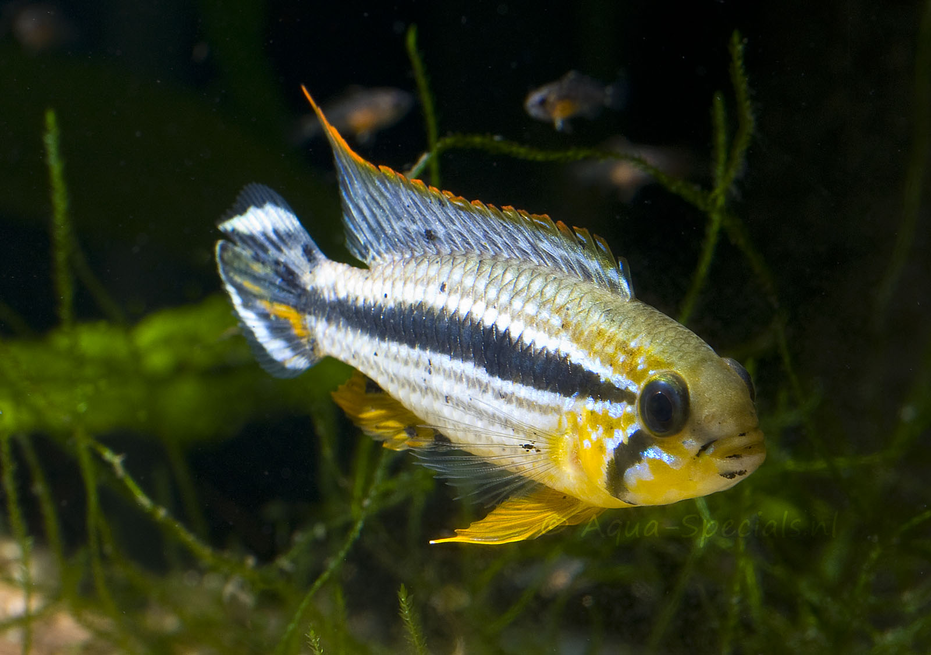
Finishing Up: Your Journey with Apistogramma Cichlids
We’ve been on quite a journey, haven’t we? From understanding their unique looks and anatomy to setting up the perfect tank, feeding them right, and even understanding their dating rituals, it’s been an exciting deep dive into the world of Apistogramma Cichlids! 🐠
But remember, while they are undeniably beautiful and fascinating, they also require a level of care and commitment. This isn’t a “set it and forget it” pet. It’s a living, breathing, color-changing, personality-filled creature that deserves your respect and attention.
Ready to embark on this adventure? Here’s a quick rundown:
- They’re small, colorful, and full of personality.
- They thrive in warm, slightly acidic water.
- They need a diet filled with live or frozen foods.
- They love hiding spots – think caves, plants, and driftwood.
- Breeding them involves a bit of matchmaking and the right conditions.
- They’re prone to some common fish diseases, but nothing a little TLC can’t fix.
- They hail from South America, and they’re pros at color-changing!
So there you have it, folks. The wonderful world of Apistogramma Cichlids! Time to set up that tank and dive in! 🐠💦

Tim Priest, a renowned aquarium expert with over 15 years of experience in aquatic gardening and fish education, is dedicated to helping enthusiasts create stunning and thriving aquatic environments. As the founder of LearnTheAquarium.com, Tim shares his wealth of knowledge, passion, and expertise through engaging articles, educational resources, and personalized advice.
Discover the secrets to creating captivating underwater landscapes and maintaining healthy aquatic ecosystems. Join Tim on an exciting journey and let your aquarium adventure begin!
